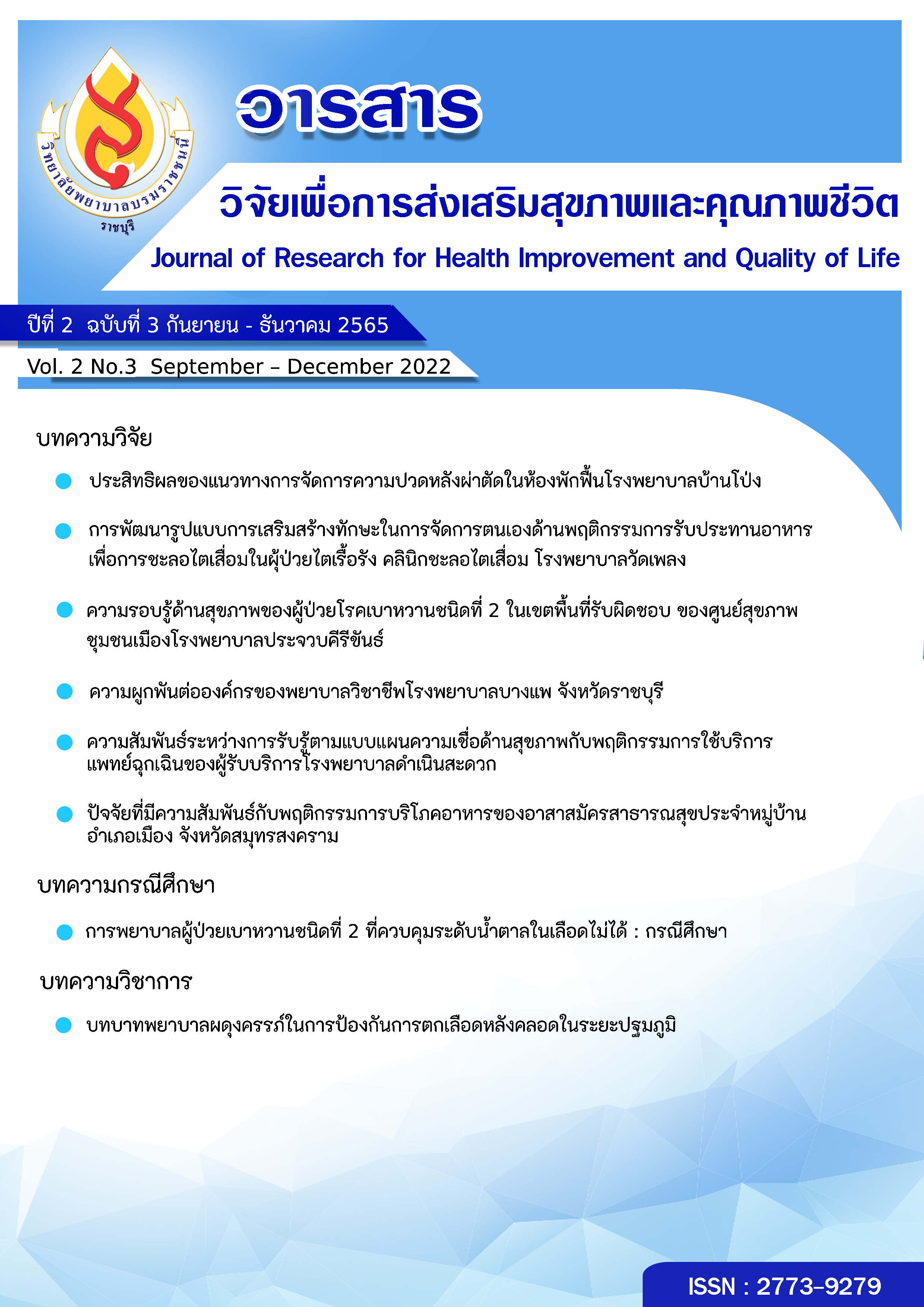บทบาทพยาบาลผดุงครรภ์ในการป้องกันการตกเลือดหลังคลอดในระยะปฐมภูมิ
คำสำคัญ:
บทบาทพยาบาลผดุงครรภ์, การตกเลือดหลังคลอดในระยะปฐมภูมิ, การป้องกันการตกเลือดหลังคลอดบทคัดย่อ
ภาวะตกเลือดหลังคลอด เป็นภาวะฉุกเฉินทางสูติกรรมที่มีคุกคามต่อชีวิตหญิงหลังคลอด ที่พบได้บ่อยและเป็นสาเหตุของการเสียชีวิตอันดับต้นของหญิงหลังคลอดในประเทศไทย ตามธรรมชาติของการคลอด หญิงหลังคลอดทุกรายมีการสูญเสียเลือดตามปกติจากการคลอดปริมาณหนึ่ง แต่ในหญิงหลังคลอดบางราย เกิดภาวะตกเลือดหลังคลอด ทำให้มีการสูญเสียเลือดปริมาณมากจนเป็นอันตรายต่อชีวิต
ภาวะตกเลือดหลังคลอดเป็นปัญหาที่สามารถป้องกัน ดูแลรักษาได้ ด้วยการบริหารจัดการตามบทบาทพยาบาลผดุงครรภ์ ประเมินความเสี่ยง 4Ts และความร่วมมือกันระหว่างพยาบาลผดุงครรภ์และทีมสุขภาพ ในการป้องกันวินิจฉัยและบริหารจัดการดูแลรักษาอย่างทันท่วงที บทความวิชาการนี้มีวัตถุประสงค์เพื่อ นำเสนอสาระความรู้ที่เป็นปัจจุบันจากการทบทวนวรรณกรรมที่เกี่ยวข้องกับข้อเสนอแนะแนวทางการป้องกันการตกเลือดหลังคลอดในระยะปฐมภูมิ บทบาทการดูแลและบริการที่มาตรฐานของพยาบาลผดุงครรภ์ เพื่อเป็นประโยชน์สูงสุดต่อหญิงหลังคลอด
เอกสารอ้างอิง
Begley, C. M., Gyte, G. M., Devane, D., McGuire, W., Weeks, A., & Biesty, L. M. (2019). Active versus expectant management for women in the third stage of labour. Cochrane database of systematic reviews.
Begum, F., Beyeza, J., Burke, T., Evans, C., Hanson, C., Lalonde, A., West, F. (2022). FIGO and the International Confederation of Midwives endorse WHO guidelines on prevention and treatment of postpartum hemorrhage. International Journal of Gynaecology and Obstetrics, 158(Suppl 1), 6.
Bureau of Reproductive Health. (2019). Bureau of Reproductive Health. Annual report 2019. . Nonthaburi: Ministry of Public Health
Carillo, A. P., & Chandraharan, E. (2014). Postpartum haemorrhage and haematological management. Obstetrics, Gynaecology & Reproductive Medicine, 24(10), 291-295.
Güngördük, K., Olgaç, Y., Gülseren, V., & Kocaer, M. (2018). Active management of the third stage of labor: A brief overview of key issues. Turkish journal of obstetrics and gynecology, 15(3), 188-199.
Keawkongthum, W. (2020). Effectiveness of Using Clinical Nursing Practice Guideline for Preventing in Early Postpartum Hemorrhage in Phatthalung Hospital. Journal of Health Science, Thaksin University, 2(3), 37-47.
Lawrie, T. A., Rogozinska, E., Sobiesuo, P., Vogel, J. P., Ternent, L., & Oladapo, O. T. (2019). A systematic review of the cost‐effectiveness of uterotonic agents for the prevention of postpartum hemorrhage. International Journal of Gynecology & Obstetrics, 146(1), 56-64.
McLintock, C. (2020). Prevention and treatment of postpartum hemorrhage: focus on hematological aspects of management. Hematology 2014, the American Society of Hematology Education Program Book, 2020(1), 542-546.
Phanttchin, C. (2018). Prevention and care of primary postpartum hemorrhage: The key roles of nurse-midwifery. Journal of Nursing Science & Health, 41(2), 134-142.
Poonperm, R., & Janasa, P. (2018). Sheehan’s Syndrome and Postpartum Hemorrhage. Journal of the Royal Thai Army Nurses, 19(2), 37-46.
Sannil, J. (2021). The Developed Clinical Nursing Practice Guidelines (CNPG) to prevent early postpartum hemorrhage (PPH) in 24 hr. In the Numchok special ward. Nakhornphanom Hospital Journal., 8(3), 1-13.
Sarakarn, W., & Charoensri, P. (2020). Nurses ’ Perceptions toward the Prevention of Early Postpartum Hemorrhage: Sunpasitthiprasong Hospital Context. Journal of Health Science Boromrajonani College of Nursing Sunpasitthiprasong, 1(4), 62-76.
Sasunee, T. (2022). Risk Factors for Postpartum Hemorrhage in Photharam Hospital, Ratchaburi Province. Journal of Health and Environmental Eucation, 7(2), 45-56.
Srisuphandit, K. (2021). Prevention. In V. Titapant & T. Lertbunnaphong (Eds.), An Illustrated Textbook: Postpartum Hemorrhage. P.A.Living Ltd., Bangkok.
Tongsong, T. (2021). Obstetrics 6. Maternal-Fetal Medicine Unit, Department of Obstetrics and Gynecology, Faculty of Medicine, Chiang Mai University. Luxsameerung Ltd., Bangkok.
Titapant, V., & Lertbunnaphong, T. (2016). An Illustrated Textbook: Obstetric Crisis. P.A.Living Ltd. Bangkok.
Titapant, V., & Lertbunnaphong, T. (2021). An Illustrated Textbook: Postpartum Hemorrhage. P.A.Living Ltd. Bangkok.
Word Health Organisation. (2018). WHO recommendations Uterotonics for the prevention of postpartum haemorrhage: Web annex 7: Choice of uterotonic agents.
Word Health Organisation. (2019). Trends in maternal mortality 2000 to 2017: estimates by WHO, UNICEF, UNFPA, World Bank Group and the United Nations Population Division: executive summary.
Erkaya, R., Karabulutlu, Ö., & Çalik, K. Y. (2021). Uterine massage to reduce blood loss after vaginal delivery. Health Care for Women International, 1-17.
Bayer, K., & Gephart, S. (2016). Delayed Umbilical Cord Clamping in the 21st Century. Advances in Neonatal Care, 16(1), 68-73.
p Khiri Khan: Ministry of Public Health. (in Thai)
ดาวน์โหลด
เผยแพร่แล้ว
ฉบับ
ประเภทบทความ
สัญญาอนุญาต
ลิขสิทธิ์ (c) 2022 วิทยาลัยพยาบาลบรมราชชนนี ราชบุรี

อนุญาตภายใต้เงื่อนไข Creative Commons Attribution-NonCommercial-NoDerivatives 4.0 International License.
บทความทีตีพิมพ์ในวารสารนี้ถือว่าเป็นลิขสิทธิ์ของวิทยาลัยพยาบาลบรมราชชนนี ราชบุรี และผลงานวิชาการหรือวิจัยของคณะผู้เขียน ไม่ใช่ความคิดเห็นของบรรณาธิการหรือผู้จัดทํา




